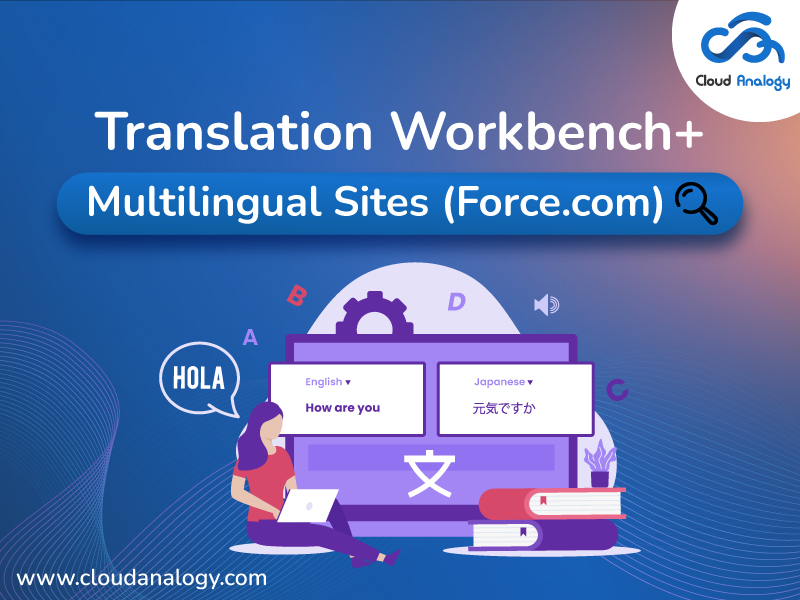Sharing is caring!
Salesforce.com allows users to work in their language of choice with a simple language attribute on their record. The salesforce.com UI is available in Danish, German, English, Spanish, Finnish, French, Italian, Japanese, Korean, Dutch, Portuguese (Brazil), Russian, Swedish, Thai, Chinese (Simplified), and Chinese (Traditional). In addition, one can use the Salesforce Translation Workbench to translate customizations to their organization or override translations from managed packages. It allows you to make assignments and filter them for better organization, improved productivity, and better accommodation for global users.
The Salesforce Translation Workbench can translate virtually everything from custom picklist values to custom fields into a supported language. Therefore, Salesforce Translation Workbench gets used in those organizations where multiple languages are enabled. It helps to specify the languages that one would like to translate and assign the translators for a specific language and create the translations for the customizations incorporated into the organization.
In this blog, we will provide insights on how to enable or disable Salesforce Translation Workbench. And, we will also take you through the steps to make the field’s label on the site page multilingual. Let us explore.
How To Enable Or Disable Salesforce Translation Workbench?
To enable the Salesforce Translation workbench to follow the steps given below.
- Go to Setup=>Administer=>Translate Workbench.
- To enable Salesforce Translation Workbench click on Translate Settings, and a new page will be opened now; click on Enable button as shown below.
- To disable Salesforce Translation Workbench, click on the Disable button as shown below.
Next, we will find the steps to make the field’s label on the site page multilingual.
What Are The Steps To Make The Fields Label On The Site Page Multilingual?
- Go to the Setup Menu, type ‘Translate’ in the search box and click on Translate.
- Click on activate.
- Click on add-on Supported Language.
- On the Setup Translate page, go to “Select the filter criteria’ and select the following options by choosing the corresponding picklist as in the below diagram:
Language > Chinese
Setup Component > Custom Field
Object > Contact
Aspect > Field Label
- Type ‘Label’ in the Quick Find Box and Click on Custom Labels
- Click ‘New Custom Label’ as in the below diagram.
- After creating ‘Custom Label,’ Click on ‘New Translation.’
- Now let’s create a Visualforce(VF) page. Type ‘Visual’ in the search box and click ‘Visualforce Pages’
- Click on ‘Preview’
- Click on your picture and click Settings.
- Change Language to Chinese. And click Save.
- Navigate back to the VF Preview tab and click Refresh
- Now you can view the labels with Custom Labels as Multilingual.
Conclusion
Salesforce is used all over the globe by a large audience for different business requirements. The salesforce.com UI is available in a whole lot of languages. The language required to interact with Salesforce organizations varies due to the geographical location and usage type. Salesforce Translation Workbench is a means adopted by Salesforce to provide users with different languages to help them to interact. Translation Workbench is a feature that allows the user to translate everything, right from picklist values, custom field labels, and Visualforce page contents. However, the Translation Workbench is unable to control the custom objects.
Want to redefine your customer relationships in today’s dynamic technological world? Connect with the expert team of Cloud Analogy, who will provide you with scalable solutions to drive more sales and enhance productivity.

Sachin Arora
Scrum Master and Principal Solutions Architect
Sachin, a renowned Scrum Master and Principal Solutions Architect at Cloud Analogy, has rich experience when it comes to working on process improvement in a fast-paced environment maintaining high level of quality in all deliverables. Sachin's expertise lies in varied hardware and software environments including Cloud technologies such as Salesforce, AWS, Cloud Foundry & Google App Engine and Mobile.Hire the best Salesforce Development Company. Choose certified Salesforce Developers from Cloud Analogy now.







